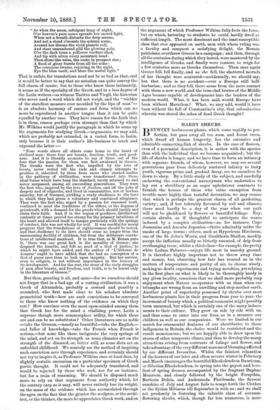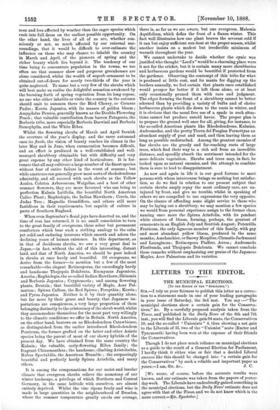HARDY SHRUBS.
BETWIXT herbaceous plants, which come rapidly to per- fection, but pass away all too soon, and forest trees,
which dwarf all human longevity, lies the extensive and admirable connecting-link of shrubs. In the case of flowers, even of a perennial description, it is rather with the species than with the individual that we become acquainted ; but the life of shrubs is longer, and we have time to form an intimacy with separate friends, of whom, however, we may see several generations pass from delicately nurtured infancy to lusty youth, vigorous prime and gradual decay, ere we ourselves 'lie down to sleep. By a little study of the subject, and carefully eschewing the conventional nurseryman who undertakes to lay out a shrubbery as an eager upholsterer contracts to furnish the houses of those who value exemption from trouble more highly than tasteful decoration, we may ensure that which is perhaps the greatest charm of all gardening, variety ; and, if but tolerably favoured by soil and climate, there need hardly be a day of the year when our path will not be gladdened by flowers or beautiful foliage. Nay, certain shrubs, as if thoughtful to anticipate the wants induced by a complex civilisation—as, for instance, Cape jessamine and Aucuba Japonica---thrive admirably midst the smoke of large towns ; others, such as Hypericum Hircinum, one of the St. John's Worts, and G-aultheria Shallon, meekly accept the infliction usually so bitterly resented, of drip from overhanging trees; whilst a third class—for example, the pretty white Ledum Palustre—enjoys life most in marshy ground. It is therefore highly important not to throw away time and money, but, observing how fate has treated us in the matters of temperature and purity of air, to choose wisely, making no doubt experiments and trying novelties, yet relying in the first place on what is likely to be thoroughly hardy in any given locality, conscious that we shall more probably reap enjoyment when Nature co-operates with us than when our triumphs are wrung from an unwilling and step-mother earth. Another point of superiority possessed by shrubs over most herbaceous plants lies in their progress from year to year, the increment of beauty which a political economist might possibly term unearned, but which is certainly one of the many induce- ments to their culture. They grow on side by side with us, and thus come to enter into our lives, as in a measure our children as well as our companions. Were we limited in our search for ornamental denizens of our shrubberies to those indigenous in Britain, the choice would be restricted and the result monotonous; but we are happily able to draw upon the stores of other temperate climes, and thus to develop the many attractions arising from contrasts of foliage and flower, and take advantage of the very different seasons of blooming affected by our different favourites. Whilst the faintest relaxation of the horrors of our later and often severer winter in February and March encourages the beautiful Rhododendron Dauricmn, or Siberian Rhododendron, to spring into the gayest and love- liest of spring dresses, accompanied by the fragrant Daphne Ifezereon, and closely followed by the bright Forsythia, Berberis Mikis, and Andromeda Floribunda, the fiercest sunshine of July and August fails to tempt forth the Clethra or the Syrian Hibiscus till September is with us ; and we shall act prudently in fostering the valuable class of autumn- flowering shrubs, which, though far less numerous, is more seen and less affected by weather than the eager species which rush into full dress on the earliest possible opportunity. On the other hand, the lives of all of us are, whether con- sciously or not, so much affected by our external sur- roundings, that it would be difficult to over-estimate the influence on those who may chance to inhabit the country in March and April, of the pioneers of spring and the richer beauty which lies beyond it. The tendency of our time being to concentrate population in the towns, we too often see that summer show and gorgeous greenhouses are alone considered, whilst the wealth of superb ornament to be obtained out-of-doors for nearly two-thirds of the year is quite neglected. To name but a very few of the shrubs which will best make us realise the delightful sensation awakened by the bursting forth of spring vegetation from its long repose, no one who either inhabits or visits the country in the autumn should omit to summon there the Bird Cherry, or Cerasus Padus ; Kerria Japonica, with its masses of golden bloom ; Amygdalus Persica, generally known as the Double-Flowering Peach ; that valuable contribution from barren Patagonia, the Berberis tribe, more especially Berberis Darwinii and Berberis Stenophylla, and the White Ribes.
Whilst the flowering shrubs of March and April furnish the overture of the year's display, and the rarer autumnal ones its finale, the vision of beauty reaches its climax in the later May and in June, when enumeration becomes difficult, and an effect is produced in a well-established and well. managed shrubbery obtainable but with difficulty and very great expense by any other kind of horticulture. It is for- tunate that all may cultivate a large number of the finest species without fear of entire failure in the worst of seasons ; but while amateurs can generally grow most sorts of rhododendrons admirably, and all succeed with such shrubs as the Yellow Azalea, Colutea .Arborescens, Weigelias, and a host of other summer flowerers, they are more favoured who can bring to perfection Kalmia Latifolia, the beautiful North American Calico Plant; Raphiolepis, the Indian Hawthorn; Cercis, the Judas Tree ; Magnolia Grandiflora, and others still more fastidious in their requirements, but capable of culture in parts of Southern England.
When even September's floral joys have deserted us, and the time of rest has returned, it is no small consolation to turn to the great family of evergreens, those sober but permanent comforters which bear such a striking analogy to the calm yet solid and enduring interests which smooth and adorn the declining years of human existence. In this department, as in that of deciduous shrubs, we owe a very great deal to Japan,—in fact, without the aid of this interesting, distant land, and that of North America, we should be poor indeed in shrubs at once hardy and beautiful. Of evergreens, we derive from the former—to mention but a few of the most remarkable—the elegant Retinosporas, the exceedingly hardy and handsome Thujopsis Dolabrata, Euonymus Japonicus, Aucuba ; Rapldolepis, the so-called Indian Hawthorn; Skimmia and Berberis Japonica ; Cryptomeria ; and among flowering plants, Deutzia ; that beautiful variety of Maple, Acer Pal- matum ; Spirma Callosa, the Red Spirwa ; Forsythia ; Kerrie,; and Pyrus Japonica. Neither is it by their quantity alone, but far more by their grace and beauty, that Japanese im- portations are conspicuous, a very large proportion of them belonging distinctly to the aristocracy of the shrub world, whilst they accommodate themselves for the most part very willingly to the climatic conditions we offer in Britain. North America, on the other hand, bestows on us Rhododendron Catawbiense, as distinguished from the earlier introduced Rhododendron Ponticum, the former grafted on the latter and other Asiatic species being the parent of most of our showy hybrids of the present day. We have obtained from the same country the Kalmia ; the valuable, early-flowering Ribes family; the fragrant Chimonanthus ; the handsome, climbing Aristolochia, Rubus Spectabilis, the American Bramble ; the surpassingly beautiful and perfectly hardy Spirtea Aritefolia, and many others.
It is among the compensations for our moist and insular climate that evergreen shrubs relieve the monotony of our winter landscape, a privilege of which Northern and Central Germany, in the same latitude with ourselves, are almost entirely deprived. Whilst the vine ripens freely and wine is made in large quantities in the neighbourhood of Dresden, where the summer temperature greatly excels our average, there is, so far as we are aware, but one evergreen, Mahonia Aquifolium, which defies the frost of a Saxon winter. This fact well illustrates how one plant braves the severest cold if it can but enjoy sufficient sun-heat at the proper season, whilst another insists on a modest but irreducible minimum of warmth throughout the year.
We cannot undertake to decide whether the cynic was justified who thought "Lord's" would be a charming place were it not for the cricket, but it is certain many more shrubberies and herbaceous gardens would be beautiful if protected from the gardener. Observing the contempt of this tribe for what is produced at little cost, and its mania for digging up the borders annually, we feel certain that plants once established would prosper far better if it left them alone, or at least only occasionally pruned them with care and judgment. The edges forming the front of a shrubbery cannot be better adorned than by providing a variety of bulbs and of choice herbaceous plants which die down to the roots in winter, and it is obvious that the usual free use of a spade in such situa- tions cannot but produce untold havoc. The proper plan is to prepare the ground well once for all, giving, for instance, to the so-called American plants like Rhododendrons, Kalmias, Andromedas, and the pretty Tierra del Fuegian Pernettyas an abundant supply of peat and sand, and then leaving them as long as possible undisturbed. Among the greatest enemies of fine shrubs are the greedy and far-reaching roots of large trees, which find their way to a rich soil from an incredible distance, and speedily absorb the nutriment intended for the more delicate vegetation. Shrubs and trees may, in fact, be looked upon as natural enemies, and the attempt to combine them is sure to lead to disappointment.
As now and again in life it is our good fortune to meet persons with whom intercourse brings us nothing but satisfac- tion, so do we find in relation to our present subject that certain shrubs amply repay the most ordinary care, are un- injured by frost, and give no trouble, whilst in speaking of others we are compelled to use expressions the very opposite. On the chance of affording some slight service to those who may be laying out a shrubbery, we may mention a few species we would from personal experience assign to the former class, naming once more the Spirma Arizefolia, with its pendant white clusters of bloom, forming, perhaps, the greatest of ornaments in an English July and Scottish August; Potentilla Fruticosa, the only ligneous member of this family, with gay and most abundant yellow bloom, produced in the same months; Amelanchier, or Snowy Mespilus; Clematis jackmanni and Laintginosa ; Retinospora, Pisifera Aurea ; Andromeda Floribunda, and Thujopsis Dolabrata. We cannot conclude these remarks without emphasising our praise of the Japanese Maples, Acer Palmatum and its varieties.







































 Previous page
Previous page